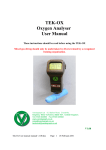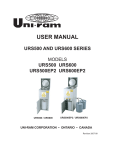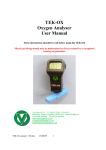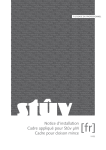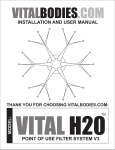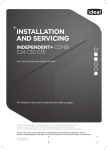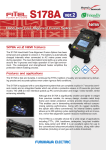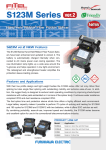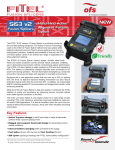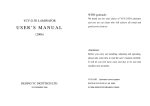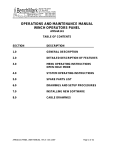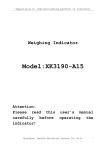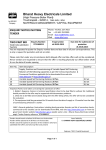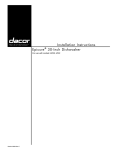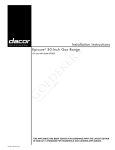Download VN202 Operators Manual - web.cdr
Transcript
VN202 Portable Oxygen Analyser Operators Manual 1.0 Introduction O The VN202 Oxygen Analyser is designed to measure the Oxygen content in a variety of gas mixtures including Nitrox and Trimix. It is recommended that the instrument only be used as a secondary measuring device to verify the concentration of Oxygen in gas mixtures prepared using other recommended methods of mixing, i.e. blending, partial pressure mixing, mixing by weight. It utilises the Teledyne R-17 Micro Fuel Cell which is a self contained galvanic cell requiring no routine maintenance. The Liquid Crystal Display (LCD) provides an easy to read indication of the Oxygen content of the gas being monitored with a resolution of 0.1%. The left hand corner of the display indicates a battery symbol when batteries are low. The front panel contains the ON/OFF push button and the calibration control. The instrument incorporates an auto switch off. Upon receipt inspect the entire unit for damage. If damaged do not use. Notify the supplier or consult Vandagraph. The analyser can be supplied on request with the auto-switch off disabled. Vandagraph VN202 User Manual Page 1 2.0 Setting Up the VN202 Oxygen Analyser 2.1 Battery Installation or replacement A 9 volt Alkaline Battery Type MN1604, PP3 or similar must be installed in the Vn202 to enable it to operate. Rechargeable batteries should NOT be used. 2.1.1 Slide off the compartment cover on the lower portion of the rear of the Analyser. 2.1.2. Clip in the battery. The battery snap connector will accept a battery only one way, do not use excessive force. 2.1.3. Take care not to damage the battery connector or wires whilst fitting the battery and replacing the battery cover. * Batteries must be replaced immediately the battery symbol appears in the LCD window. Accuracy of the VN202 can not be guaranteed whilst this battery symbol is visible. 2.2 Sensor Installation A Teledyne R-17 Sensor must be installed before the VN202 will operate. Remove the sensor from its protective bag and visually inspect the sensor for damage or electrolyte leakage. Allow sensor a few minutes to stabilise after installation. * Never use a defective or suspect sensor. The R-17 sensor electrolyte is caustic. Do not let the electrolyte come into contact with skin, eyes or mouth. If it does, flush the affected area with fresh water. See section (16) on First Aid. Do not attempt to open or repair the sensor. Check the sensor regularly for leaks. Leaking or exhausted sensors should be disposed of in accordance with local regulations which is usually similar to the disposal of batteries. Consult the material safety data sheet section (15). Plug the jack on the coiled cable gently but firmly into the sensor and tighten locking ring with fingers. 2.3 The Flow Thru Divertor The Flow Thru divertor is designed to be used in conjunction with the Tee Piece and only in flowing gas. Flowing gas diverted onto the sensor face improves the response time. Failure to remove the divertor and Tee when using a bag to measure the Oxygen content will severely lengthen the response time and can cause substantial inaccuracies. In a stationary gas the Flow Thru divertor traps the residual Oxygen rich gas in the area just above the sensor membrane and severely slows down the ingress of fresh air into the sensor. A sensor left in the air with the Flow Thru adapter in situ can take several minutes to return to 20.9% when removed from an Oxygen enriched gas. Calibration will be inaccurate during this period. * Moving gas is essential when using the Flow Thru adapter. Page 2 Vandagraph VN202 User Manual 3.0 Calibration Switch on VN202 Analyser Remove the Flow Thru Divertor if fitted. Blow gently across the face of the sensor face. Wait for the sensor to show a dip in reading to about 17% (due to CO2 in breath), recover, and then slowly stabilize. Do not hold the sensor in the palm of the hand as heat from the body can affect the reading. Adjust the Calibration control until the LCD reads 20.9% at sea level. N.B. The VN202 measures partial pressure so will be affected by altitude and re-compression chambers. Sensors deteriorate very slowly and near the end of their useful life may show a drift downwards soon after calibration. * Sensors should be checked periodically with 100% Oxygen. 4.0 100% Oxygen Calibration The easiest method is to place the sensor without the Flow Thru divertor in a plastic bag with small pin holes. Ensure the neck of the bag is held closed. Slowly introduce 100% Oxygen via a small tube and flush several times. When stable, set calibration to 100%. Remove the sensor from the bag. Blow gently over the sensor face. The VN202 reading should fall to about 17% (due to the CO2 in breath) and the settle at between 20% and 22%. If the sensor is outside these limits, repeat the calibration. Ensure all the Oxygen has been flushed out of the sensor during the air calibration. * If calibration is in a confined space ambient Oxygen levels may build up beyond 21%. Check in fresh air. Allow adequate ventilation in measuring area. The most accurate method of measuring 100% Oxygen is to use the Flow Thru Divertor, Tee Piece and tubing connected to a restrictor part number DIN22F. Flush with 100% Oxygen at a flowrate not exceeding 5 Litre/minute (a gentle stream of gas giving an audible hiss). When the reading is steady set 100% with calibration control. Flush with air. This could be from a SCUBA cylinder containing air. Do not exceed 5 Litre/minute. The reading should fall and reach a level between 20% and 22%. * If sensor cannot be calibrated correctly do not use and consult your supplier. Always calibrate in air prior to making a measurement as temperature changes and movement of the calibration control can all cause the calibration to accidentally move from 21%. For Oxygen mixtures above 50% always calibrate in 100% before measurement. Vandagraph VN202 User Manual Page 3 5.0 Measurement of Oxygen in Diving Cylinders There are two recommended methods of using the VN202 to measure Oxygen in a diving cylinder. O2 Sensor R17 Pressure restrictor DIN22F Flow Thru Adaptor B-50057 Tubing VP12 'O' Ring Din thread Tee A-268 Tubing to Tee Adaptor D22M10 5.1 Oxygen Measurement direct from a Pillar valve The pressure restrictor DIN22F has a standard DIN fitting which can be used directly into a DIN pillar valve or into an A clamp with a DIN Female fitting. The pillar valve should be opened slowly until the gas can just be heard hissing through the tubing. Close the pillar valve after 5 seconds. Watch the Vn202 reading, it should rise and reach a stable level. If it reaches a maximum and then falls back, the cylinder has been opened too much creating a pressure on the sensor. After the reading stabilises (about 10 seconds) open the valve again for 5 seconds as above. The reading should this time peak and fall back less than 0.5%. The stable reading is the oxygen level in the cylinder gas. If in doubt this step can be repeated as many times as necessary until a stable reading is achieved. If the system is left in this position air will gradually find its way back up the tubing and the reading will begin to fall very slowly. The secret of accurate fast measurement is gently opening the pillar valve enough to obtain a gas flow of about 2-5 ltrs per minute (a low level hiss) without creating a high pressure on the sensor. The pressure restrictor in conjunction with the pillar valve is used to achieve low flow rates of gas from the cylinder. The Flow Thru adapter is a set of blades which divert the gas down onto the sensor face. The gas flow to the sensor is therefore turbulent ensuring a fast reading. The tubing is added to prevent air being drawn into the Tee outlet and reducing the reading. Any poor joints will create a venturi action and suck in air giving an inaccurate reading. Page 4 Vandagraph VN202 User Manual 5.2 Measurement of Oxygen using a plastic bag Remove the Flow Thru Divertor if fitted and Calibrate in air 20.9%. Do not hold the sensor in the palm of the hand as heat from the body can affect the reading. The VN202 measures partial pressure so will be affected by altitude and re-compression chambers. Purge the demand valve to clear any air compressed in the hose and first stage. Place the sensor in a plastic bag with small pin size holes along with the demand valve. The sensor membrane should be located beside the demand valve mouthpiece. * Do not point the sensor into the mouthpiece. Ensure the neck of the bag is held closed. Purge the Demand valve for 2 seconds. The reading should rise. Purge again twice more, two seconds each and in between squeeze the gas out of the bag gently. A third final purge should give a steady reading. N.B. the reading may peak higher than the real value temporarily due to excessive pressure in the bag. If the reading stabilises then quickly begins to fall, the air holes are too big or the neck of the bag is not being held firm enough. Remove the sensor from the bag and blow gently over the sensor face. The sensor should slowly return to 20.9%. If the reading fails to return to 20.9%, repeat calibration. Ensure all the oxygen has been flushed out of the sensor during the air calibration. N.B. The system should always be calibrated in air 20.9% before it is used for a measurement. The measured gas should always be within 1% of the calculated mixture. If a discrepancy of more than 1% is found check the analyser in 100% O2 and air 20.9%. * Do not assume the analyser is correct. If in doubt double check Other methods such as holding the sensor or sensor Tee against the pillar valve, or the mouthpiece of the demand valve are strongly discouraged. These methods can allow high pressures into the sensor giving inaccurate high readings or can allow air to be drawn into the gas mixture giving inaccurate low readings. * Excessive pressure can permanently damage the sensor membrane. Vandagraph VN202 User Manual Page 5 6.0 Repair Service In the event the VN202 requires servicing the following steps will ensure a swift response. 6.1 Sensor Failure All sensors have serial numbers and have a 12 month warranty from date of purchase. Contact your authorised distributor or Vandagraph for return instructions. For sensors under warranty a copy of the sales invoice or proof of purchase and the sensor serial number intact must be included on return. 6.2 Instrument Failure There are no user replaceable parts in the instrument. The case has been sealed and the electronics section tropicalised to retard water damage. Contact your authorised distributor or Vandagraph for return instructions. If the instrument is unrepairable, a replacement service exchange unit, excluding sensor, will be offered to you on receipt of the damaged VN202 at a maximum fixed low charge. (approximately 30% of the current list price of complete instrument). Each replacement instrument will have a full 12 months warranty. Warranty does not cover physical damage, damage from liquids or physical abuse. 7.0 Spare Parts And Accessories R-17 DINKIT Includes: A-268 B-50057 VP12 D22M10 BS111 DIN22F R-17 Micro Fuel Cell DINKIT Restricter Kit A-268 Tee Adaptor B-50057 Flow-Thru Divertor VP12 Tubing 30cm D22M10 Male adapter BS111 Viton O Ring DIN22F Pressure Restrictor 8.0 Storage of Sensors Never • Store sensors for long periods before use. • Subject sensors to high temperatures i.e. (Car rear shelf) • Freeze sensors (left in cars overnight) • Subject sensors to physical shocks. • Subject sensors to vacuum • Submerge sensors in liquids • Attempt to open a sensor Sensors deteriorate very slowly and near the end of their useful life may show a drift soon after calibration. Sensors should be checked periodically in 100% Oxygen. Page 6 Vandagraph VN202 User Manual 9.0 Environmental effects on Oxygen measuring 9.1 Pressure Virtually all Oxygen analysers measure the partial pressure and not the percentage of the gas they sense. The only time these instruments can accurately read percentages is when the pressure is atmospheric (1 Bar) and does not vary between calibration and measurement. It is therefore important to calibrate the VN202 at regular intervals. It is recommended that the unit be calibrated prior to each use. At sea level in air the partial pressure of Oxygen is approximately 0.21 and the percentage of Oxygen will therefore read approximately 21%. If the sensor was subjected to 2 BAR pressure in air it would read 42% (Partial pressure 0.42 Bar). Pressures of this magnitude may be experienced by the sensor if it is placed on the output of the pillar valve, or mouthpiece and therefore facing into the gas flow. O2 READING 40% 20% ALTITUDE 0 BAR 1 BAR 2 BAR If a container or bag is used to contain the gas to be measured it must have pin size vent holes and the pressure must be allowed to return to ambient before a measurement is made. Wind increases pressure and if directed on to the sensor face during calibration can cause erratic readings. The VN202 readings will be affected by altitude and re-compression chambers. Altitude Km 30 25 20 15 10 5 1.0 0.8 Vandagraph VN202 User Manual 0.6 0.4 0.2 Pressure BAR 0.0 Page 7 10.0 Temperature The Teledyne R-17 is a micro-fuel cell and a galvanic electrochemical sensor. It is sensitive to temperature changes. A thermistor in the R-17 Oxygen sensor adjusts for ambient changes in the range 0 - 40C (31 - 106F). Cold gas from a cylinder directed at the face of the sensor will change the temperature and affect the accuracy of the reading. The temperature compensating circuit is in the base of the sensor so holding the sensor in the palm of a hand can warm it causing inaccuracy. OUTPUT Thermistor Circuit Compensated Output Cell Output TEMPERATURE 11.0 Humidity For calibration purposes humidity does not directly affect the accuracy of the sensor however: Excessive moisture or condensation on the sensor surface will block diffusion of Oxygen to the sensor and render it inoperative. In high humidity atmospheres hold the sensor facing down during calibration. Any droplets will have a chance to fall off the sensor membrane. Using the restricter method with air from a cylinder for calibration will allow the following dry gas to evaporate any moisture on the sensor face. Discrepancy in readings against expected values The VN202 is intended to be used only as a secondary means to verify the accuracy and check the concentration of oxygen in a pre-mixed source. Whenever a discrepancy of +/- 1% or greater is observed between the calculated mix and the VN202 the source of the discrepancy must be resolved immediately. * Check gas calculations * Check method of preparation * Check VN202 calibration both in air and 100% O2 Page 8 Vandagraph VN202 User Manual 12.0 Water & Moisture Water in the sensor or the VN202 can render the instrument inaccurate and cause irreparable damage. Sea water may dry leaving a deposit on connectors and sensor membrane. Always leave the sensor jack locking ring finger tight on the sensor socket. The instrument has been constructed to reduce the effects of water splashed onto it but 100% waterproofing is not guaranteed. Signs of water in the battery compartment should be treated as a potential instrument failure. If the VN202 is dropped in sea water quickly remove the battery. Wipe the wet area with fresh water and leave the VN202 battery cover off in a warm area for several days. Check the sensor membrane. If it is wet rinse with fresh water. Remove excess water carefully with a paper tissue and leave to dry in a warm area. If the jack socket on the sensor is wet the sensor is probably destroyed as the electronics inside the sensor will also be wet. Wash out with fresh water and leave to dry out in a warm area. If all the salt is removed corrosion may be prevented. * Before use check sensor calibration in both air and 100% oxygen if moisture has been a problem. Water ingress into the VN202 can be assumed if any of the following are observed. Dampness in the battery compartment Micro droplets in the LCD window Mist in the LCD window Missing segments or digits Battery goes flat prematurely 13.0 Specification Range Accuracy Response Time Resolution Battery Type Battery Life Sensor Type Sensor Life Sensor output Dimensions Weight Length Storage Temp Operating Temp Case : 0 - 100% Oxygen : +/- 1% of full scale reading : 90% in less than 10 seconds : 0.1 % : 9 Volt Alkaline (NOT rechargeable) : 12 months (typical) : R-17 (Galvanic) : Expected 48 months in air (10 months in 100% oxygen) : 7mV - 13mV in air (10.5mV nominal) : 60mm x 120mm x 25mm : 205 gm incl battery & sensor : 250mm retracted 759mm extended : 0-50 C (recommended 10-30C) : 0-40 C : Splash Proof Vandagraph VN202 User Manual Page 9 14.0 DO’S and DON’TS DO Read all of the directions before using for the first time Calibrate before use Keep the unit, sensor, and connections dry Calibrate after replacing the batteries Calibrate after replacing the sensor Calibrate in air before every reading Make sure the R-17 is properly attached Visually inspect the sensor for leakage or water on the sensing surface before use Use the plastic Flow Thru divertor when using the Tee Piece Remove the Flow Thru divertor when measuring in a bag Clean the case with damp cloth and mild detergent Remove the batteries prior to extended storage DON’T Use the VN202 if you suspect any malfunction Overheat or freeze the sensor Open or try to repair a leaking or broken sensor Immerse the sensor or instrument in any liquid Pass hot or cold gas mixtures over the sensor face Expose the unit to radio, short wave, microwave, X-Ray, high-frequency, or electromagnetic radiation Use cleaning agents or liquids in the cable receptacles or around the battery compartment Place the VN202 unit in a water vapour saturated environment Expose the VN202 or sensor to excessive sunlight Expose the VN202 or sensor to temperatures greater than 40 C (106 F) or less than 0 C (-32 F) Use without locking the jack plug Use if low battery indicator shows Page 10 Vandagraph VN202 User Manual 15.0 Sensor Material Safety Data Sheet Product Identification Product Name : Micro-Fuel Cells R-17 Manufacturer : Teledyne Brown Engineering Address : 16830 Chestnut Street : City of Industry : CA 91749 Date Prepared or Last Revised Emergency Phone Number Physical and Chemical Data Chemical and Common Names CAS Number Melting Point/Range Boiling Point/Range Specific Gravity pH Solubility in Water Percent Volatiles by Volume Appearance and Odour : 08/08/91 : 001 818 961 9221 : Potassium Hydroxide (KOH), 15% (w/v) : Granular Lead (Pb), pure : KOH 1310-58-3 : Pb 7439-92-1 : KOH : 10 to 0 C : 100 to 115 C : 1.09 @ 20 C : >14 : Soluble : None : Colourless : Odourless Pb 328 C 1744 C 11.34 N/A Insoluble N/A Grey Metal Odourless 15.1 Physical Hazards Potential for fire and explosion The electrolyte in the Micro-Fuel Cells is not flammable. There are no fire or explosion hazards associated with Teledyne R-17 sensors. Potential for reactivity: The sensors are stable under normal conditions of use. Avoid contact between the sensor electrolyte and strong acids. Vandagraph VN202 User Manual Page 11 15.2 Health Hazard Data Primary route of entry : Ingestion, eye/skin contact Exposure limits OSHA PEL : .05 mg/cu.m (Pb) ACGIH TLV : 2 mg/cu.m. (KOH) Effects of over-exposure Ingestion : The electrolyte could be harmful or fatal if swallowed. Oral LD50 (RAT) = 3650 mg/kg : The electrolyte is corrosive; eye contact could result in permanent Eye loss of vision. : The electrolyte is corrosive; skin contact could result in a chemical Dermal burn. Inhalation : Liquid inhalation is unlikely. Signs/symptoms of exposure Contact with skin or eyes will cause a burning sensation and/or feel soapy or slippery to touch. Medical conditions : None Aggravated by exposure : NTP Annual Report on Carcinogens: Not Listed Carcinogenity : LARC Monographs: Not Listed : OSHA: Not Listed Other health hazards : Lead is listed as a chemical known to the State of California to cause birth defects or other reproductive harm. 16.0 Emergency and First Aid Procedures Eye Contact : Flush eyes with water for at least 15 minutes and get immediate medical attention. Skin Contact : Wash affected area with plenty of water and remove contaminated clothing. If burning persists, seek medical attention. Ingestion : Give plenty of cold water. Do not induce vomiting. Seek medical attention. Inhalation : Liquid inhalation is unlikely. 17.0 Handling Information The Oxygen sensors are sealed, and under normal circumstances, the contents of the sensors do not present a health hazard. The following information is given as a guide in the event that a cell leaks. : Rubber gloves, chemical splash goggles Protective clothing Clean-up procedures : Wipe down the area several times with a wet paper towel. Use a fresh towel each time. Page 12 Vandagraph VN202 User Manual 17.1 Protective Measures During sensor replacement: before opening the bag containing the sensor, check the sensor for leakage. If the sensor leaks, do not open the bag. If there is liquid around the sensor e.g. whilst in the instrument case, put on gloves and eye protection before removing the sensor. 17.2 Disposal Should be in accordance with all applicable state, local and federal regulations. NOTE: The above information is derived from the MSDS provided. The information is believed to be correct but does not purport to be all inclusive and shall be used only as a guide. Neither Teledyne Brown Engineering nor Vandagraph Ltd shall be held liable for any damage resulting from handling or from contact with the above product. 18.0 General Care of the VN202 The VN202 is a very accurate instrument and if looked after will give many years of accurate Oxygen measurement. There are very few parts to wear out and the instrument is robust and designed to be used in the diving environment. The instrument should be cleaned with warm soapy water (Not immersed). No detergents or solvents should be used on the sensor. Never use the VN202 once the low battery indicator is visible. From this point the electronics quickly become unstable and will give false readings. Do not subject the VN202 to mechanical shocks. Although robust the LCD display is a glass component and can be broken. This is usually apparent by black areas spreading across the LCD screen. The VN202 should be kept in a container when not in use and should be shielded from high and low temperatures. Do not leave on the dashboard or rear window shelf of a car. Protect the LCD from long periods of sunlight. Good quality batteries should last at least one year (NOT rechargeable). Alkaline batteries are recommended because of their expected life, discharge curves and overall reliability and stability. Take care when changing the batteries not to break the battery wires or distort the connections. Try not to trap wires in the battery cover. Vandagraph VN202 User Manual Page 13 19.0 Care of the Sensor The sensor should be checked with an air calibration a week before each dive trip (allowing time for a replacement to be obtained) and always just prior to a measurement being taken. The sensor can also be cleaned with warm water but care should be taken to follow the advice on page 9 concerning moisture. Do not use excessive force to screw the sensor into the Flow-Thru divertor as damage can be caused to the threads. 20.0 Sensor Life The life of a sensor in the VN202 depends on the amount of Oxygen to which it is exposed and is not affected by whether the VN202 is switched on or off. A Teledyne R-17 will theoretically work for 48 months if left in air and 10 months if left in 100% 02. The sensor warranty is 12 months from the invoice date. These expected life figures can be drastically shortened if the sensor is physically abused. The sensor should be stored with the VN202 in the same protective case when it is not being used. 21.0 VN202 Accuracy The readout device has a 0.1% resolution and can therefore only display with a maximum accuracy of +/- 0.1% anywhere on the scale. During Vandagraph quality control each VN202 is tested for accuracy and linearity over the complete range 0% to 100%. An insignificant error is involved in matching the temperature compensation network to the sensor output curve. Most errors contributing to inaccuracy are user or environment induced. e.g. temperature, movement, pressure or moisture. If care is taken to observe the correct procedures during calibration and measurement an accurate calibration at 20.9% should give a maximum error of +/- 0.5% in 100% Oxygen. Readings below 21% will have an accuracy limited to the resolution of +/-0.1% * The overall accuracy claimed is +/- 1% of full scale. Note, that errors in calibration at 20.9% will be multiplied by 5 at 100%. e.g. set 20% in air will cause 100% Oxygen to read 95%. Page 14 Vandagraph VN202 User Manual 22.0 Trouble Shooting Symptom Possible Cause What to do No reading Battery symbol visible Check connections Battery Reads zero or very low Sensor connections Will not calibrate Sensor exhausted Sensor exhausted Replace Battery Check connections Replace battery Clean sensor cable Plug & rotate gently in sensor to remove any deposits in sensor socket Replace sensor Replace sensor Reads only above 21% Erratic reading Oxygen trapped Sensor exhausted Sensor connections Sensor nearly exhausted Windy Conditions Digits incomplete, Random Digits, No Digits, LCD Cloudy, Battery contacts are discoloured Instrument dropped or wet Remove Flow Thru-divertor Replace sensor Clean sensor cable Plug by rotating sensor cable plug in socket Check for large swings in readings when sensor is turned upside down Wind affects pressure on sensor surface and causes calibration problems. Shield from wind Dry out and/or Return to Vandagraph Helpline Contact on Phone : +44 (0) 1535 634900 Email : [email protected] Fax : +44 (0) 1535 635582 Although every attempt has been made to ensure that the information contained in this data is correct, Vandagraph Ltd accept no liability for errors or the misrepresentation of this material. This monitor should only be used by trained and certified Nitrox divers. V2.4 March 2007. Copyright Vandagraph Ltd. All rights reserved. Vandagraph VN202 User Manual Page 15 Table of Contents Chapter 1 2 2.1 2.2 2.3 3 4 5 5.1 5.2 6 6.1 6.2 7 8 9 9.1 10 11 12 13 14 15 15.1 15.2 16 17 17.1 17.2 18 19 20 21 22 Contents Introduction Setting up the VN202 Oxygen Analyser Battery installation or replacement Sensor installation Flow Thru Divertor Calibration 100% Oxygen calibration Measurement of oxygen in diving cylinders Measurement of oxygen using a pillar valve Measurement of oxygen using a plastic bag Repair service Sensor failure Instrument failure Spare parts and accessories Storage of sensors Environmental effects on Oxygen measuring Pressure Temperature Humidity Water & moisture Specification Do’s and Don’ts Material safety data sheet Physical hazards Health hazard data Emergency and first aid procedures Handling Information Protective measures Disposal General care of the VN202 Care of the sensor Sensor life Accuracy of the VN202 Trouble shooting Page 1 2 2 2 2 3 3 4 4 5 6 6 6 6 6 7 7 8 8 9 9 10 11 11 12 12 12 13 13 13 14 14 14 15 VANDAGRAPH Ltd 15 Station Road, Cross Hills, Keighley, West Yorkshire, England, BD20 7DT, UK Tel: +44 (0) 1535 634900 Fax: +44 (0) 1535 635582 www.vandagraph.co.uk Page 16 Vandagraph VN202 User Manual

















